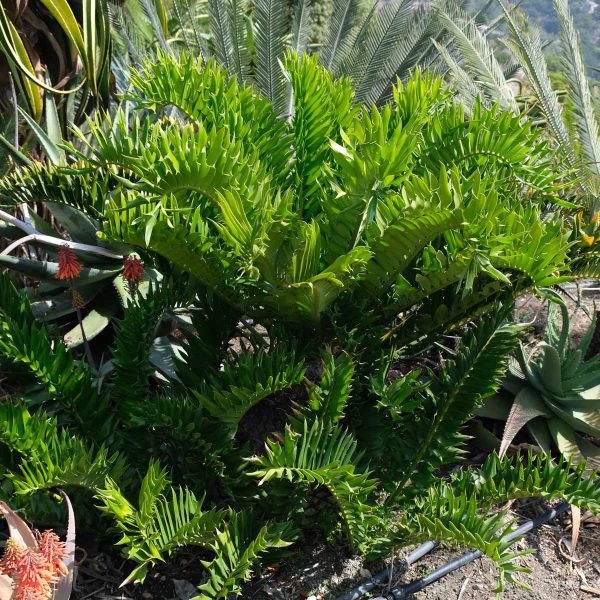Whatapp:
+278.3675.0634
Work Hours
Monday to Friday: 7AM - 7PM
Weekend: 10AM - 5PM

Price range: $27.00 through $70.00
Encephalartos latifrons, commonly known as the Albany Cycad, is a very rare and critically endangered species of cycad native to the Eastern Cape
Encephalartos latifrons, commonly known as the Albany Cycad, is a very rare and critically endangered species of cycad native to the Eastern Cape province of South Africa, typically found at elevations between 200 and 600 meters.
It is a tall, tree-like cycad with stems up to 3 to 4.5 meters high and 30 to 45 cm in diameter.
The plant usually has branched stems at the base and may produce suckers
Leaves are the broadest among cycad species, glossy, dark green, hard, and rigid, measuring 1 to 1.5 meters long with a curved or curled leaf stalk
The leaflets are large, leathery, and arranged at a sharp angle along the central spine, partially overlapping with triangular lobes on the lower edges (Encephalartos latifrons)
It is dioecious, meaning male and female cones occur on separate plants. Male cones are cylindrical and olive-green, while female cones are barrel-shaped and also olive-green. Seeds are red and egg-shaped
It naturally grows on rocky outcrops and hills among scrub vegetation in areas with hot, dry summers and cool, frost-free winters
The species is presumed to be insect-pollinated, like most cycads.
Encephalartos latifrons is classified as Critically Endangered by the IUCN, with fewer than 100 plants known in the wild and no natural seed production or seedling recruitment observed
The species has suffered from habitat loss due to agriculture and especially from illegal removal for trade as garden ornamentals, which remains the greatest threat
It is protected by national and international legislation, and ex situ conservation efforts, such as those at Kirstenbosch Botanical Garden, maintain some of the remaining genetic diversity
The wild population is estimated at about 70 mature individuals based on recent surveys.
The Albany Cycad grows slowly but does well in cultivation with well-drained soil, full sun, and cool frost-free winters. It is sensitive to high humidity and strong irrigation jets, which can damage the plant
The slow growth rate of Encephalartos latifrons significantly complicates conservation efforts in several ways:
Recovery from population losses exceedingly slow , meaning that any removal of plants from the wild, whether by illegal collection or habitat disturbance, has long-lasting impacts on population size and viability. This slow growth limits natural population recovery and recruitment, making the species functionally extinct in some areas where individuals are too isolated to reproduce naturally
Because plants take many years to mature and reproduce, sexual propagation and seedling recruitment are extremely rare, which restricts natural regeneration and the ability to rebuild wild populations without human intervention
The slow growth rate also means that ex situ conservation and augmentation programs require long-term commitment, as plants take a long time to reach reproductive maturity and produce offspring. This slows down efforts to increase population numbers through reintroduction or supplementation
Translocation or restoration efforts face additional challenges since slow-growing plants are vulnerable to mortality during and after translocation, and establishing self-sustaining populations in suitable habitats takes considerable time and careful planning
Overall, the slow growth rate necessitates a comprehensive, multi-faceted conservation approach combining strict protection of remaining wild plants, habitat management, ex situ cultivation, and carefully planned augmentation to prevent genetic erosion and promote population recovery over decades
In summary, the very slow growth of E. latifrons means that conservation actions must be patient, long-term, and proactive to counterbalance the species’ limited natural regeneration capacity and vulnerability to threats
In summary, Encephalartos latifrons is a rare, slow-growing cycad with broad leaves, critically endangered due to illegal collection and habitat pressures, with ongoing conservation efforts focused on protecting remaining wild plants and maintaining cultivated populations
| Sizes | Small, Medium, Large |
|---|
Reviews
There are no reviews yet.